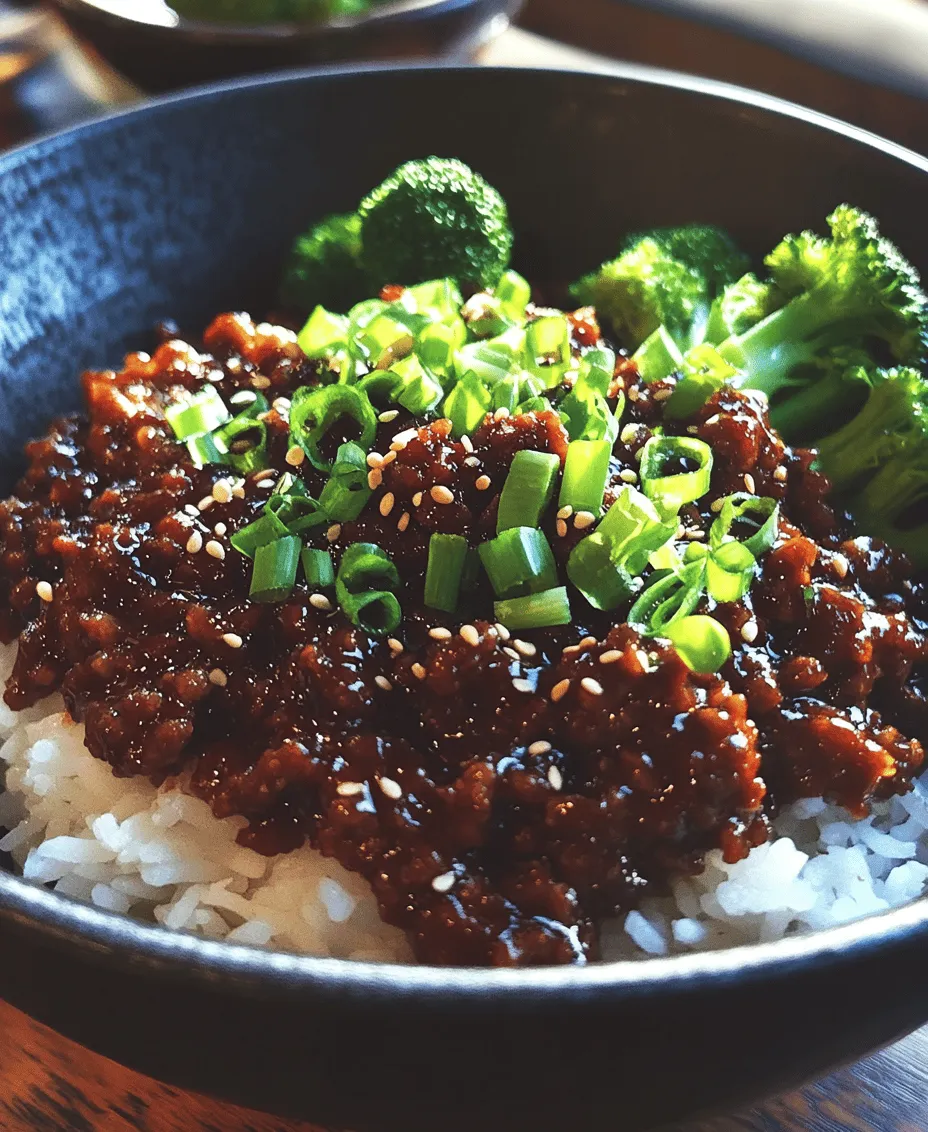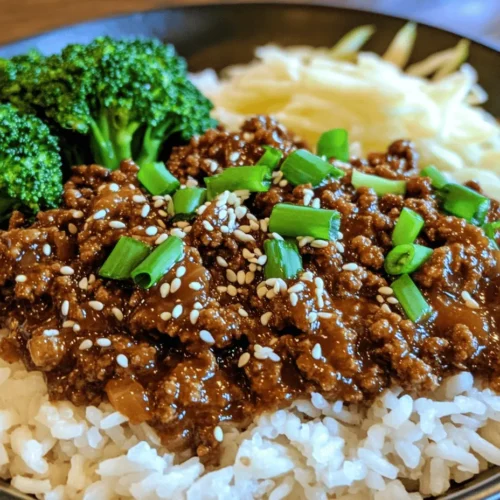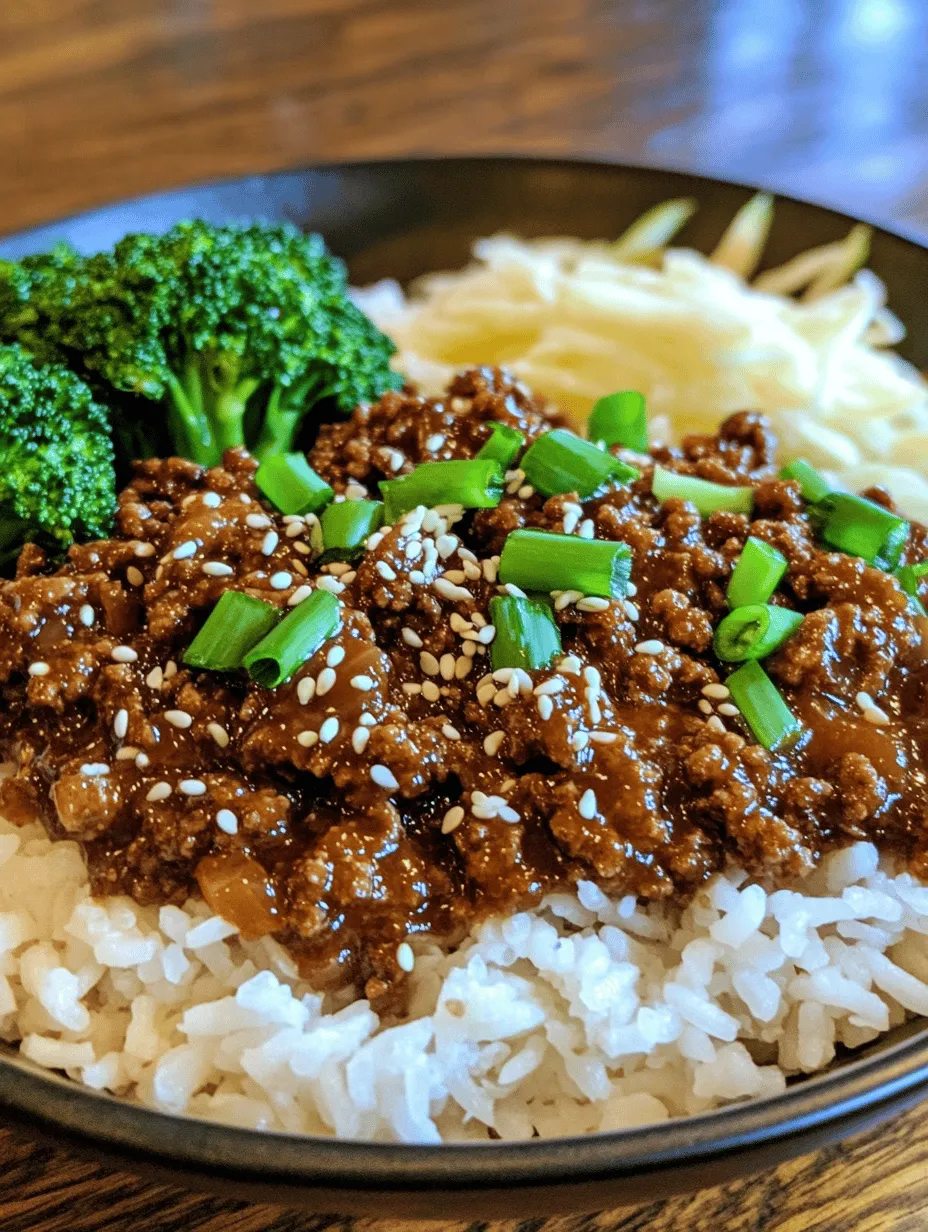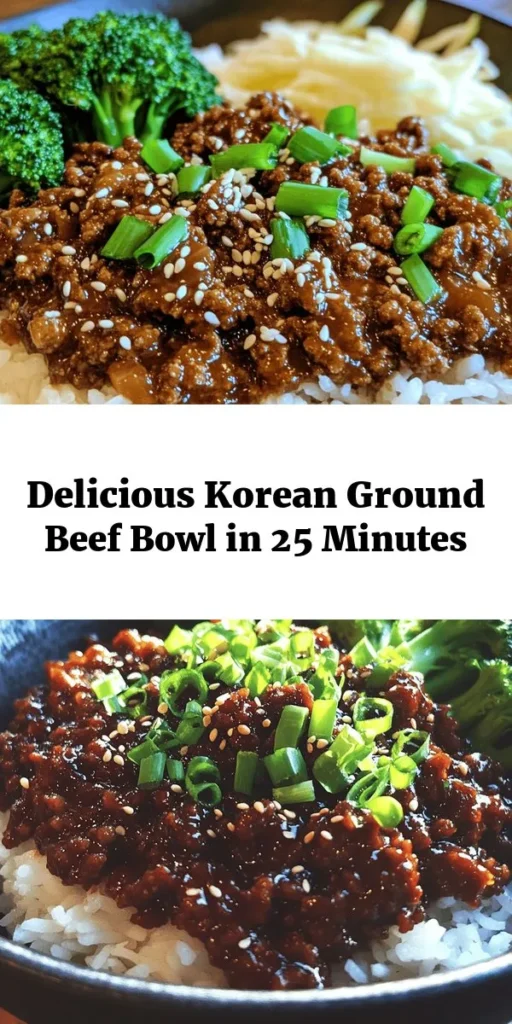Explore the rich and savory world of Korean cuisine with this delectable Korean Ground Beef Bowl recipe. This dish combines the robust flavors of ground beef with a tantalizing sauce that features gochujang, a staple in Korean cooking known for its unique balance of heat and sweetness. Ideal for busy weeknights or a cozy weekend meal, this recipe is not only quick to prepare but also customizable, allowing you to add your favorite vegetables. Whether you’re a seasoned home cook or a kitchen novice, this Korean Ground Beef Bowl is sure to impress and satisfy.
Understanding the Ingredients
Creating a delicious Korean Ground Beef Bowl starts with selecting the right ingredients. Each component plays a vital role in building the dish’s flavor profile. Let’s dive into the essential ingredients that make this recipe shine.
Highlighting Ground Beef: Choosing the Right Cut
Ground beef is the star of this dish, and choosing the right cut is crucial for achieving the perfect texture and flavor. While you can use any type of ground beef, opting for ground chuck is an excellent choice due to its balanced fat content, which typically sits at around 80/20 (meat to fat). This ratio provides enough moisture and flavor without being overly greasy. If you prefer a leaner option, ground sirloin (90/10) is also suitable, though it may result in a slightly drier dish.
The Role of Aromatics: Garlic and Ginger in Korean Cooking
Aromatics are the backbone of many Korean dishes, providing depth and complexity to the flavors. In this recipe, garlic and ginger are essential ingredients. Fresh garlic adds a pungent, savory note, while ginger introduces a warm, peppery flavor that complements the sweetness of the gochujang. For the best results, use fresh garlic and ginger instead of powdered versions, as the fresh ingredients provide a more vibrant taste. Finely mincing both ensures that their flavors infuse the beef effectively during cooking.
Soy Sauce and Gochujang: The Essential Flavor Components
Soy sauce is a must-have in Korean cooking, imparting umami richness and saltiness to the dish. When selecting soy sauce, opt for a high-quality brand to ensure the best flavor. For this Korean Ground Beef Bowl, you can use either regular or low-sodium soy sauce, depending on your dietary preferences.
Gochujang, a fermented Korean chili paste, is another crucial ingredient that brings both heat and sweetness to the table. Its unique flavor profile is what sets this dish apart from other ground beef recipes. If you’re new to gochujang, you’ll find it in the Asian section of most grocery stores or at local Korean markets. Just a spoonful can elevate the entire dish, so be sure to incorporate it generously!
The Importance of Sesame Oil: Enhancing Flavor
Sesame oil is a staple in Korean cuisine, known for its nutty aroma and rich flavor. In this recipe, a drizzle of sesame oil adds depth and rounds out the dish beautifully. Use toasted sesame oil for a more intense flavor, as it enhances the overall profile while providing a fragrant finish. Just a small amount goes a long way, so be mindful of the quantity to prevent overpowering other ingredients.
Optional Add-Ins: Vegetables for Nutrition and Color
One of the best aspects of the Korean Ground Beef Bowl is its versatility. You can easily customize it by adding a variety of vegetables, making it not only delicious but also nutritious. Some popular options for this dish include bell peppers, carrots, zucchini, and snap peas. These vegetables not only add color and texture but also contribute essential vitamins and minerals. Feel free to use any seasonal veggies you have on hand, and don’t hesitate to experiment with different combinations to find your favorite mix.
Step-by-Step Instructions
Now that we’ve covered the ingredients, it’s time to get into the cooking process. Follow these detailed steps to create a flavorful Korean Ground Beef Bowl that will have your taste buds dancing.
Preparing the Flavorful Sauce
Before diving into cooking the beef, it’s essential to prepare the sauce that will infuse the dish with its signature flavors. Start by gathering your ingredients: soy sauce, brown sugar, gochujang, and rice vinegar. This combination of ingredients will create a rich, sticky sauce that clings beautifully to the beef.
– Mixing Soy Sauce, Brown Sugar, Gochujang, and Rice Vinegar: In a medium bowl, combine ¼ cup of soy sauce, 2 tablespoons of brown sugar, 2 tablespoons of gochujang, and 1 tablespoon of rice vinegar. Whisk the mixture until the sugar dissolves and the ingredients are fully incorporated. The balance of sweetness from the brown sugar and the heat from the gochujang will create a deliciously complex flavor that complements the beef perfectly.
– Tips for Achieving the Perfect Consistency: If you prefer a thicker sauce, you can add a teaspoon of cornstarch mixed with a tablespoon of water to the sauce mixture. This will help it cling to the beef more effectively.
Cooking the Beef
Now that the sauce is ready, let’s move on to cooking the ground beef. This step is crucial for achieving a great texture and flavor.
– The Best Techniques for Browning Ground Beef: Heat a large skillet over medium-high heat and add a tablespoon of vegetable oil. Once the oil is hot, add 1 pound of ground beef. Break the beef apart with a wooden spoon or spatula, ensuring it cooks evenly. Allow the beef to brown without stirring too frequently, as this helps develop a nice sear and enhances the overall flavor.
– Importance of Draining Excess Grease: Once the beef is fully browned, it’s essential to drain any excess grease from the skillet. This step will prevent the dish from becoming too oily. Use a slotted spoon to remove the beef and place it in a bowl, then carefully pour off the excess grease, leaving just enough to keep the beef moist.
– Infusing Aromatics: With the skillet still hot, it’s time to add the aromatics. Add minced garlic (about 3 cloves) and ginger (1 tablespoon) to the skillet. Sauté for about 30 seconds, stirring constantly to prevent burning. This will release their essential oils and enhance the flavor profile of the dish.
– Timing and Techniques for Adding Garlic and Ginger: Timing is critical when adding garlic and ginger. Always add them after the beef is browned, as their delicate flavors can easily burn if exposed to high heat for too long. Once you notice the garlic starting to become fragrant and golden, it’s time to move on to the next step.
Combining the Ingredients
Now that the beef is perfectly browned and infused with the aromatic flavors of garlic and ginger, it’s time to combine everything.
– How to Properly Coat the Beef with Sauce: Return the drained ground beef to the skillet and pour the prepared sauce over it. Stir well to ensure that every piece of beef is evenly coated with the sauce. The heat from the skillet will help the sauce thicken slightly as it cooks.
– Tips for Simmering to Enhance Flavor: Allow the mixture to simmer for about 5 minutes over medium heat, stirring occasionally. This simmering process will enable the flavors to meld together beautifully, creating a harmonious blend that defines the dish. If you find the sauce too thick, you can add a splash of water to reach your desired consistency.
Assembling the Bowls
With the beef mixture ready, it’s time to assemble your Korean Ground Beef Bowls. The beauty of this dish lies in its presentation, so take care to arrange the ingredients thoughtfully.
– Serve Over Rice: Start with a generous scoop of steamed white or brown rice as the base of your bowl. The fluffy rice will soak up the flavorful sauce, providing a delicious backdrop for the savory beef.
– Add Your Vegetable Choice: Next, layer on your chosen vegetables. You can either serve them raw for a fresh crunch or quickly sauté them in the skillet for a couple of minutes until they’re slightly tender. Popular choices include sliced cucumbers, shredded carrots, and steamed broccoli, which not only add color but also enhance the nutritional value of the dish.
– Garnish with Toppings: To finish, consider garnishing the bowls with sesame seeds, chopped scallions, or a drizzle of additional sesame oil. These finishing touches will not only elevate the visual appeal of the dish but will also add layers of flavor and texture.
This Korean Ground Beef Bowl recipe is more than just a meal; it’s a celebration of flavors and an opportunity to explore the rich tapestry of Korean cuisine. With its simple preparation and customizable nature, it’s a dish that fits seamlessly into any weeknight dinner routine or special occasion. As you continue to explore the world of Korean cooking, this recipe will serve as a foundation for countless variations and adaptations. Stay tuned for the final steps and tips to make this dish your own!

Choosing the Right Rice: Jasmine vs. Sticky Rice
When preparing a Korean Ground Beef Bowl, selecting the right rice is pivotal to achieving the perfect balance of flavor and texture. Two popular choices are Jasmine rice and sticky rice, each offering distinct characteristics that can enhance your dish.
Jasmine Rice is a long-grain rice known for its fragrant aroma and slightly nutty flavor. It cooks up fluffy and separate, making it an excellent base for the savory ground beef. Its light texture allows the rich flavors of the beef and sauce to shine through without overwhelming the palate.
Sticky Rice, on the other hand, is a short-grain rice that becomes gluey when cooked. Its chewy texture provides a delightful contrast to the tender beef and adds a unique mouthfeel to the dish. This type of rice is particularly popular in many Asian cuisines and can help to soak up the flavors of the sauce, making each bite deliciously satisfying.
Ultimately, your choice between Jasmine and sticky rice will depend on personal preference. If you prefer a light, fragrant accompaniment, go with Jasmine rice. If you are looking for a heartier texture that clings to the meat, sticky rice is the way to go.
Presentation Techniques for a Restaurant-Quality Look
Presentation is key when it comes to elevating your Korean Ground Beef Bowl from simple to stunning. Here are a few techniques to help you serve your dish like a pro:
1. Layering: Start by placing your rice at the bottom of the bowl, followed by a generous serving of the ground beef mixture on top. This layering not only looks appealing but also allows the juices from the beef to seep into the rice, enhancing the flavor.
2. Color Contrast: Aim for a colorful presentation by adding vibrant vegetables and garnishes. The contrast between the dark beef, white rice, and colorful toppings will create a visually appealing dish that is as satisfying to look at as it is to eat.
3. Bowl Choice: Use shallow, wide bowls to give your dish room to breathe. This allows you to artfully arrange your ingredients and makes it easier for guests to mix the components together as they enjoy their meal.
Garnishing for Visual Appeal
Garnishing adds that finishing touch that transforms your dish into a masterpiece. Here are some garnishing tips for your Korean Ground Beef Bowl:
The Role of Sesame Seeds and Green Onions: Toasted sesame seeds add both flavor and visual appeal to your dish. Their nutty taste complements the savory notes of the beef, while their small size adds texture without overpowering the other ingredients. Sprinkle a handful of toasted sesame seeds over the beef just before serving.
Green onions (or scallions) are another essential garnish. Finely chop them and sprinkle them over the top for a fresh, crisp bite. Their vibrant green color not only adds a pop of color but also enhances the overall flavor profile of the dish.
Additional Garnish Ideas for Added Flavor
You can take your garnishing a step further by incorporating additional flavors and textures:
– Cilantro: Fresh cilantro adds an herbal note that contrasts nicely with the richness of the beef. Use it sparingly to avoid overpowering the dish.
– Pickled Vegetables: Adding a side of pickled radishes or cucumbers can provide a tangy crunch that balances the savory and sweet flavors of the bowl.
– Chili Flakes: For those who enjoy a bit of heat, a sprinkle of red pepper flakes can give your dish an extra kick and enhance its visual appeal with a dash of red.
Serving Suggestions
Once your Korean Ground Beef Bowl is beautifully presented and garnished, it’s time to consider how to serve it for the best dining experience.
Pairing with Vegetables: Steamed Broccoli and Bok Choy: To create a well-rounded meal, serve your beef bowl with a side of steamed vegetables. Broccoli offers a nice crunch and complements the flavors of the dish, while bok choy adds a tender, leafy green element. Both vegetables are rich in nutrients and can be seasoned lightly with soy sauce or sesame oil for added flavor.
Side Dish Ideas: What Complements the Korean Ground Beef Bowl: Traditional Korean side dishes, or banchan, can elevate your meal. Consider serving kimchi, a staple in Korean cuisine, as it provides a spicy, fermented flavor that pairs wonderfully with the savory beef. Additionally, a simple cucumber salad dressed with vinegar and sesame oil can refresh the palate and add a crisp contrast.
Beverage Pairings: Drinks to Enhance Your Meal Experience: To complement your Korean Ground Beef Bowl, consider offering beverages that pair well with the dish. Traditional choices include Korean soju or makgeolli, a fermented rice drink. If you prefer non-alcoholic options, a chilled barley tea (bori-cha) is refreshing and complements the flavors of your meal beautifully.
Nutritional Information
Understanding the nutritional value of your Korean Ground Beef Bowl can help you appreciate its health benefits while enjoying the dish.
Breakdown of Nutritional Values per Serving: A typical serving of this dish contains approximately 400-500 calories, depending on portion sizes and the type of rice used.
Caloric Content and Macronutrients: The dish provides a balanced mix of macronutrients, with about 25-30 grams of protein from the ground beef, 40-50 grams of carbohydrates from the rice, and 15-20 grams of fat, primarily from the cooking oil and any garnishes like sesame seeds.
Health Benefits of Key Ingredients: Ground beef is an excellent source of protein, which is essential for muscle growth and repair. It also contains vital nutrients like iron and zinc. The addition of vegetables not only boosts fiber content but also introduces a variety of vitamins and minerals, contributing to a well-rounded meal.
Exploring Variations of the Korean Ground Beef Bowl
One of the great aspects of the Korean Ground Beef Bowl is its versatility. Here are some variations you can explore:
Vegetarian Alternatives: Replacing Beef with Tofu or Lentils: For a vegetarian version, substitute ground beef with crumbled tofu or lentils. Tofu takes on the flavors of the marinade beautifully, while lentils provide a hearty texture and protein content. Simply follow the same cooking instructions, adjusting cooking times as necessary.
Spicy Additions: How to Adjust the Heat Level: If you enjoy spicy food, consider adding more gochujang to the beef mixture or mixing in some chopped fresh chilies. You can also serve the dish with a spicy kimchi or a side of chili oil for those who want to customize their heat level.
Seasonal Variations: Incorporating Fresh, Local Vegetables: Embrace the seasons by incorporating locally sourced vegetables. In the spring, add asparagus or snap peas; during summer, consider bell peppers or zucchini. Fall vegetables like sweet potatoes or winter greens can also be delicious additions to this dish.
Cultural Significance of Korean Cuisine
Korean cuisine is rich in history and deeply rooted in cultural traditions. Understanding its significance can enhance your appreciation for dishes like the Korean Ground Beef Bowl.
The Role of Beef in Korean Dishes: Beef has long been a prized protein in Korean cooking, associated with special occasions and traditional feasts. Its versatility means it can be prepared in various ways, from grilling to stewing, each method showcasing the quality and flavor of the meat.
Understanding Gochujang: Its History and Importance: Gochujang, a fermented chili paste, is a staple in Korean kitchens and adds a unique depth of flavor to many dishes, including the Korean Ground Beef Bowl. Its origins date back centuries, and it represents the essence of Korean flavors—spicy, sweet, and savory.
The Rise of Korean Cuisine in Global Food Trends: In recent years, Korean cuisine has gained international popularity, with dishes like bibimbap, bulgogi, and kimchi becoming household names. The balance of flavors, emphasis on fresh ingredients, and health benefits of Korean food have made it appealing to a global audience.
Conclusion
Savor the delightful flavors of Korea with this quick and easy Korean Ground Beef Bowl recipe. Packed with savory, sweet, and spicy elements, this dish is a perfect representation of Korean culinary traditions while being adaptable to your personal taste. Whether enjoyed alone or as a shared meal with loved ones, this recipe brings a taste of Korea into your home, making it a must-try for any food enthusiast. Embrace the versatility of this dish by exploring different variations, serving suggestions, and garnishing techniques, and enjoy a unique dining experience that celebrates the richness of Korean cuisine.



